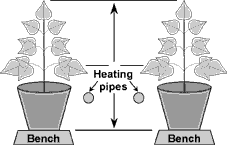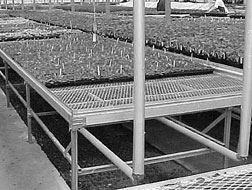
Figure 1. Efficient position of heating pipes given by Teitel et al. 1999.
Jessica J. Prenger
Research Engineer
Peter P.
Ling
Assistant Professor
The methods for heating greenhouses are constantly re-evaluated due to pressures for energy conservation, pollution prevention, and most importantly, efficient production. Heating distribution systems that are lower in the greenhouse and closer to plants achieve substantial energy savings and are more effective at maintaining warm canopy temperatures. Keeping the temperature of leaf surfaces above the dew point is an excellent way to prevent condensation and thus fight common greenhouse diseases. Further, new approaches to disease and pest management require careful attention to the microclimate of crops, using heating and humidity to treat diseases and even affect insect behavior. The following discussion lists recommendations for bottom and between-row heating, which provide a better environment for plant production with energy savings as well.
One of the most common greenhouse heating systems is a network of metal or plastic pipes distributing steam or hot water. Pipe heating is an effective means of warming crops both by convectively heating the greenhouse air and by radiating heat directly to the leaves. Nevertheless, there are several ways to increase efficiency. The key to improving climate control with pipe heating systems is locating the pipes nearer or below the crop. First, lowering overhead pipes can result in up to 20% energy savings because of more direct heating of the plants and less radiation loss through the transparent cover (Bakker et al. 1995). Placing the pipes lower to the ground also stimulates air movement through the crop canopy. Warm air rising through the canopy removes moisture and creates a uniform microclimate around the plants. The most successful radiative heating from pipes occurs at the mid-height of the crop (Figure 1), while the least effective horizontal placement is directly between benches. Thus, the best position for pipes is between the mid-height and bottom of the crop, with pipes closer to the benches rather than between them (Teitel et al. 1999).
The disadvantages of low pipe position are that the pipes need to be resistant to horticultural chemicals, and they must not hinder cultivation. Some systems are now adjustable to allow growers to move pipes out of the way during cultivation. Lowering the pipe system does require careful attention so that crops are not scorched by adjacent pipes.
A widely accepted improvement of pipe heating systems is warm floor heating. Heat is provided through a hot water or steam pipe system below the soil or concrete floor surface. The main advantage is homogenous heat delivery throughout the greenhouse from the large heat transfer surface of the floor. Heating from the bottom of the greenhouse allows warm air to rise through the plant canopy, providing better circulation of the heat. In addition, heating the root zone positively affects plant health and growth (Bakker et al. 1995). However, the system does have disadvantages, most notably the slow response time to control actions, and the relatively high expense of the installation. The expense is significantly offset by the improved heating efficiency of the system. In some cases, systems can pay for themselves within a year (Kelly, 1994). Often supplemental forced air or pipe heating is used to provide a quicker response time.

Bench heating is another technique to maximize the surface area for heat transfer. Some growers place pipes directly under or on the benches to conduct heat to the root zone of the plants, and improve air movement through the canopy (Figure 2).

Forced air heaters offer a quick-response system for greenhouse heating. These heaters are often overhead, with heat distributed by fans or perforated polyethylene tubes. As with pipe and floor heating, air heating systems can be improved by lowering the heating ducts. Under-bench air heating ducts have been shown to significantly decrease Botrytis infections (Kelly, 1994). The main disadvantage of using air heat is the expense of running a fan to move the heated air, which can add 10% to energy costs (Bakker et al. 1995). Another problem is that air heating is a convective heat process, meaning it requires air to transfer heat; thus, the leaf temperatures cannot reach any higher than the air temperature. Alternatively, radiative heating such as solar radiation and radiative heat from pipes or heated floors can heat the leaves higher than the temperature of the air. Further, the on-off periods of air heating can leave the canopy temperature cooler than air temperature for much of the heating cycle, allowing condensation to form. The following table shows estimates of energy efficiency for four heating systems. Note that a "near-floor" system is almost as efficient as the best "warm floor" system.
| Heating System | Estimated Heating System Efficiency |
|---|---|
| Perfect Heating System | 100% |
| Warm Floor-Insulated* | 90% |
| Warm Floor-Uninsulated* | 75% |
| Hot water pipes, Near-Floor | 85% |
| Hot Air: Unit Heater, Fan jets and Tube | 60% |
| *Supplemental pipe heating needed approximately 15% of the
time. From The Ohio State University, Department of Food, Agricultural,
and Biological Engineering, 1984. Estimated for a densely cropped flower or vegetable production, night temperature 60-65¢XF. | |
Moving the heating distribution system lower in the greenhouse improves heat transfer to the plants and helps prevent low canopy temperatures that lead to condensation problems. This results in a better climate around the plant canopy and significant energy savings. Moreover, the efficiency of heating systems can be significantly improved by locating heating surfaces nearer to the crops. Additional considerations for better climate control such as using thermal blankets to conserve heat, and circulating air to better distribute heat are discussed in fact sheets AEX-802 and AEX-803.
Aldrich, R.A. and J.W. Bartok, Jr. 1989. Greenhouse Engineering. NRAES-33. Northeast Regional Agricultural Engineering Service. Cornell University, Ithaca, NY.
Bakker, J.C. et al. (Eds.) Greenhouse Climate Control-An integrated approach. Wageningen, The Netherlands: Wageningen Pers. 1995.
Kelly, M.K. "The Well-Ventilated Greenhouse." GrowerTalks. April 1994: 54-57.
Teitel, M., I. Segal, A. Shklyar, and M. Barak. 1999. A Comparison of Pipe and Air Heating Methods for Greenhouses. J. Agric. Eng. Res. 72:259-273.